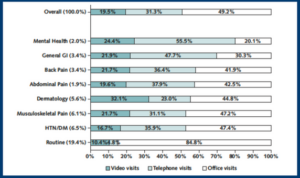Kaiser Permanente study finds continued low rate of in-person visits following phone or video care
During the COVID-19 pandemic, Kaiser Permanente patients became much more likely to visit their primary care doctor by video or phone. New research finds these patients had similar medical outcomes whether they saw their doctor in-person or virtually.

In a study published October 16 in Annals of Internal Medicine, investigators with the Kaiser Permanente Division of Research (DOR) compared treatment and follow-up visits for 1.5 million patients between April and December 2021, the second year of the pandemic.
They found the primary care visits nearly evenly split between in-person or virtual. Patients returned for a follow-up office visit within 7 days in 1.3% of in-person visits, 6.2% of video visits, and 7.6% of telephone visits. Follow-up in the emergency department was low across the type of initial visit (1.6% office, 1.8% video, 2.1% telephone).
The results are similar to a previous analysis by this study team examining outcomes for telehealth provided just after the pandemic began in April 2020. This new study reflects how virtual care performed as patients and doctors began using it more routinely, beyond the initial emergency period.
“These findings, on top of our previous research, suggest that telemedicine looks like it’s addressing a need, without generating major signs of safety concerns,“ said lead author Mary Reed, DrPH, a DOR research scientist. “We’re also not seeing the outcomes shift over time; they are fairly stable, and that’s good news.”
The authors found differences in follow-up rates by the reason for the visit; follow-up was most likely for virtual visits for abdominal or musculoskeletal pain, and least likely for virtual visits for mental health.
“This finding makes sense because a clinician may want to follow-up with a physical exam for someone with continuing physical pain, while a mental health related visit may more often be addressed virtually,” Reed said. “The reassuring thing is that the degree to which patients return to care after telemedicine is pretty limited.”
The analysis showed 2.3 million primary care visits during the study period included 49.2% office visits, 19.5% video visits, and 31.3% telephone visits.
Telehealth was used more often than in-person visits for certain health concerns, such as mental health (80% of visits were virtual), followed by general gastrointestinal issues (70%), back pain (58%), and abdominal pain (57%).
Antibiotics were prescribed in 6.6% of office visits, 6.6% of video visits, and 6.7% of telephone visits.

For clinicians, the findings are reassuring, said senior author Anjali Gopalan, MD, MS, a DOR research scientist and senior physician with The Permanente Medical Group. “We aren’t seeing overtreatment in the setting of virtual care, given the potential for a provider to order a test or antibiotic to be on the safe side, without a physical exam,” Gopalan said. “The ideal future state will be finding the balance in choosing the primary care modality that reflects both patient preference for convenience along with clinical appropriateness.”
The study was funded by the Agency for Healthcare Research and Quality.
Additional co-authors were Jie Huang, PhD, Madeline Somers, MPH, MS, and Andrea Millman, MA, of the Division of Research; Emilie Muelly, MD, PhD, of The Permanente Medical Group; Loretta Hsueh, PhD, of the University of Illinois in Chicago; and Ilana Graetz, PhD, of Emory University.
# # #
About the Kaiser Permanente Division of Research
The Kaiser Permanente Division of Research conducts, publishes and disseminates epidemiologic and health services research to improve the health and medical care of Kaiser Permanente members and society at large. It seeks to understand the determinants of illness and well-being, and to improve the quality and cost-effectiveness of health care. Currently, DOR’s 600-plus staff is working on more than 450 epidemiological and health services research projects. For more information, visit divisionofresearch.kaiserpermanente.org or follow us @KPDOR.





This Post Has 0 Comments